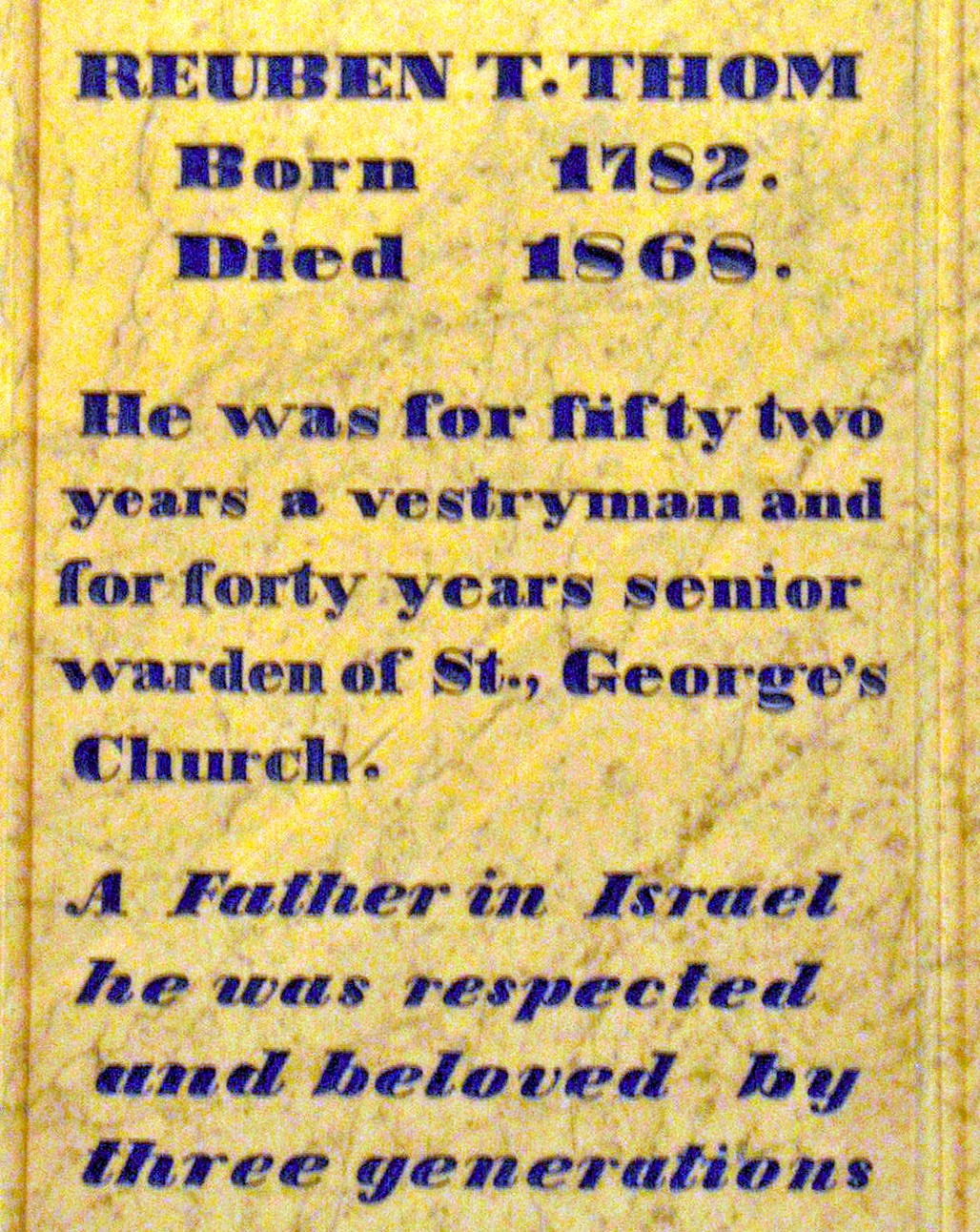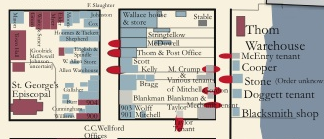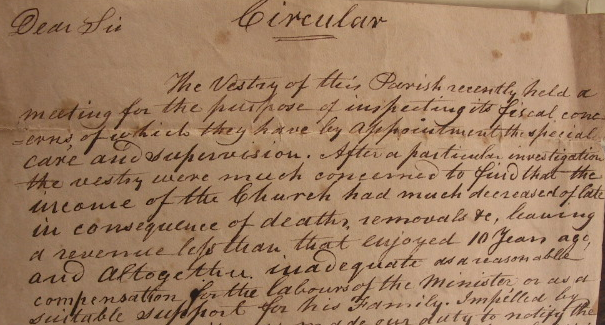

There are two marble plaques inside the Church toward the front. One of the individuals is well-known – Rev. Edward McGuire who served the Church for 45 years from 1813-58. The other plaque on the right or south side of the Church honors a gentleman less well known – Reuben Thom. Together they dominated St. George’s in the 2nd Church 1815-1849 and through the first half of the 19th century. Thom’s obituary in the Fredericksburg Ledger was on the front page in 1868 – McGuire didn’t get that billing when he died.
Reuben Thom was on the Vestry for 52 years and is the longest serving Vestry member in our history. Remarkably, he was senior warden for 40 of those 52 years. (Vestry rotation did not begin until 1946). Like McGuire he is buried in St. George’s Cemetery though not originally. His grave was moved there in 1932 and was one of the last burials. As they faced each other in life, so too in death.
Unfortunately we know little about their working relationship. However, we know it was more than cooperation since Thom was one of five men to attest to McGuire’s will. In addition, they were affiliated with many of the same organizations in Fredericksburg, namely the American Colonization Society, Female Academy, Auxiliary Prayer Book and Tract Society.

Thom worked as a postman and lived on Caroline Street in an 1822 home between George and William Streets, current occupied by the Salem Shops. (See map on left from the Park Service showing businesses and homes around St. George’s during the Civil War). He also owned a warehouse on the river (the stone warehouse today). The post office was on the first floor and he resided on the second.
The 1850’s were a boom year for business and he had to enlarge the numbers of boxes on more than one occasion. Thom did well. In 1860 when he was 78, he had real estate worth $24,000 (approximately $500,000 in today’s market) and estate $5,500 (just under $150,000) . He had 4 children and owned 7 slaves. Like McGuire, he was a member of the local chapter of the American Colonization Society which wanted to send African Americans to Liberia in Africa as a just solution to the slavery issue. We have evidence of Thom freeing at two of his slaves during his lifetime.
Thom was a small man in statute – only five feet tall. Dabney H. Maury, the uncle of Matthew Fontaine Maury, wrote in his recollections the following story about Thom: “Once when the Episcopal Convention was assembled in Saint George’s, a dangerous crack was discovered in the gallery of the church, and great apprehension prevailed as to the safety of the building. The senior warden indignantly derided these fears, and, when the convention opened, the amazed congregation saw their warden seated in the gallery, his arms folded, and his back propping the dangerous crack.”
Maury provided some hints on her character and demeanor. “He was a man of strictest integrity and absolute sobriety, and was never known to take a drop of strong drink; but his ruddy face was adorned by a prominent nose of flaming and suspicious redness.” Based on the reading of accounts in his post office, he had a wry sense of humor.

During the 1862 bombardment of Fredericksburg on December 11th one of the early rounds pierced his home. He fled to the basement and then to the garden with what valuables he could take. Later that evening he reached the safety of Lee’s lines on Marye’s Heights though without his valuables. After the battle he returned to town and lived off contributions from the fund established to aid Fredericksburg residences rendered homeless. He rebuilt in 1863 in another part of town.
In 2009, I found a November, 1835 circular written by Thom at the Heritage Center where our records are stored. We have very few records from 1817-1865 since our Vestry minutes and other church records were presumably burned in Richmond. A portion of the Circular is reproduced . The issue that Thom discusses is not unusual – lack of monitory support for the Church and even the minister’s family.
Thom notes the Vestry members have increased their pledges and he asks the congregation to do the same. He says the revenues were “less than enjoyed 10 years ago.”
He may have been reacting over recent communicant trends. The Church listed 100 communicants in 1820 which had risen to 114 in 1829. After a successful revival in 1831 the communicants swelled to 188 but by the time Thom wrote, the number was writing was down to 160. Still the count was larger than the 103 the Church had a decade earlier in 1825, and the Church revenues should have increased though he notes deaths in the Church that had a negative impact. He had “confident expectation” that the congregation would understand the issue and each parishioner would “contribute so fair a claim upon your Christian liberality.” Thom’s confidence was rewarded. By the Civil War the communicants had rise to the 280’s. Given the ability to support the new church the financial crisis must have passed.
One side pursuit was his service as President of Aqueduct Company which provided water to Fredericksburg before there was a public water company and even lasted until 1964. Their main source was the springs on William Street just east of Trinity Church today. In the heyday they supplied water through four cast iron pipes to 100 customers from Hanover Street to Princess Anne.
Thom died in May, 1868 at the age of 82. As the Fredericksburg Ledger wrote: We have never known “a man of more sterling honesty, more transparent truth or cooler courage.” His remarkable life spanned the early American Republic, the Jacksonian years and the years prior to the Civil War as well as the War and the beginning years of Reconstruction. 52 of those years was given to service to St. George’s and with Rev McGuire served all three St. George’s Church buildings. Not surprisingly, according to his obituary, “Among his last utterances were fervent prayers for the prosperity of the Church.”
